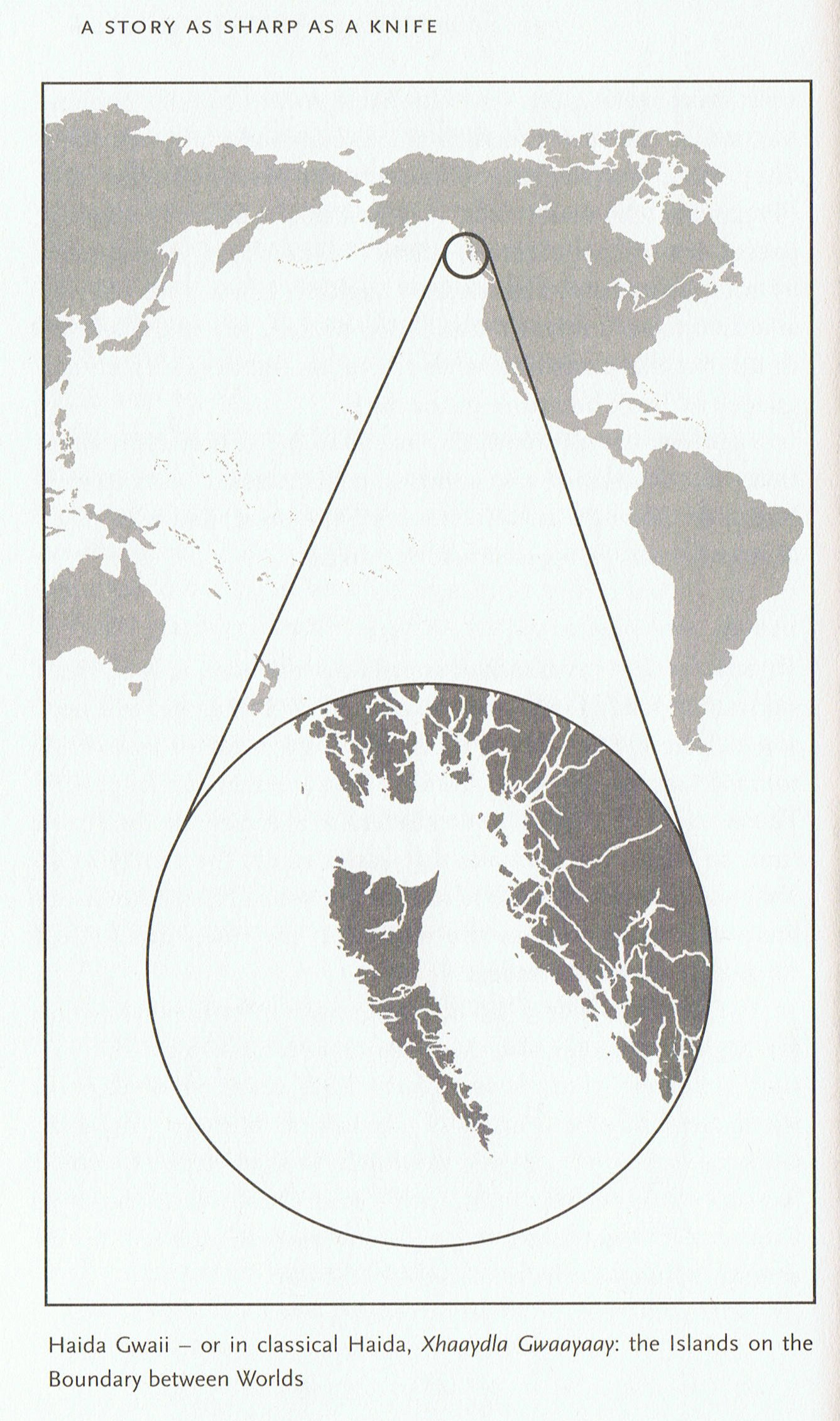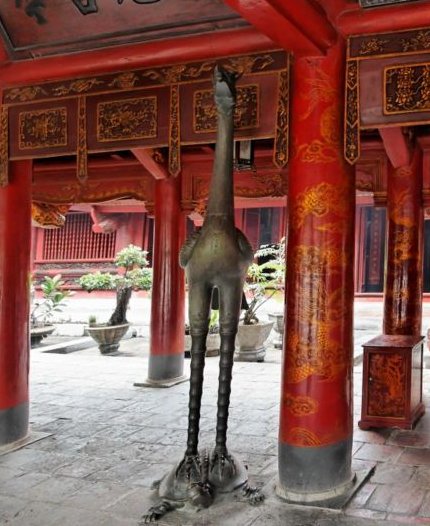In order to better understand what
happened next, when Hotu Matua arrived to Easter
Island, it may be convenient to first make a detour to
the land of the Haida people (Haida Gwaii):

|
"In
the morning of the world, there was
nothing but water. The Loon was calling,
and the old man who at that time bore
the Raven's name, Nangkilstlas,
asked her why. 'The gods are homeless',
the Loon replied. 'I'll see to it', said
the old man, without moving from the
fire in his house on the floor of the
sea. Then as the old man continued to
lie by his fire, the Raven flew over the
sea. The clouds broke. He flew upward,
drove his beak into the sky and
scrambled over the rim to the upper
world. There he discovered a town, and
in one of the houses a woman had just
given birth.
The Raven stole the skin and form of the
newborn child. Then he began to cry for
solid food, but he was offered only
mother's milk. That night, he passed
through the town stealing an eye from
each inhabitant. Back in his foster
parents' house, he roasted the eyes in
the coals and ate them, laughing. Then
he returned to his cradle, full and
warm. He had not seen the old woman
watching him from the corner - the one
who never slept and who never moved
because she was stone from the waist
down. Next morning, amid the wailing
that engulfed the town, she told what
she had seen. The one-eyed people of the
sky dressed in their dancing clothes,
paddled the child out to mid-heaven in
their canoe and pitched him over the
side.
He turned round and round to the right
as he fell from the sky back to the
water. Still in his cradle, he floated
on the sea. Then he bumped against
something solid. 'Your illustrious
grandfather asks you in', said a voice.
The Raven saw nothing. He heard the same
voice again, and then again, but still
he saw nothing but water. Then he peered
through the hole in his marten-skin
blanket. Beside him was a grebe. 'Your
illustrious grandfather asks you in',
said the grebe and dived. Level with the
waves beside him, the Raven discovered
the top of a housepole made of stone. He
untied himself from his cradle and
climbed down the pole to the lowermost
figure.
Hala qaattsi ttakkin-gha,
a voice said: 'Come inside, my
grandson.' Behind the fire, at the rear
of the house, was an old man white as a
gull. 'I have something to lend you',
said the old man. 'I have something to
tell you as well. Dii hau dang iiji:
I am you.' Slender bluegreen things with
wings were moving between the screens at
the back of the house. Waa'asing dang
iiji, said the old man again: 'That
also is you.'
The old man gave the Raven two small
sticks, like gambling sticks, one black,
one multicoloured. He gave him
instructions to bite them apart in a
certain way and told him to spit the
pieces at one another on the surface of
the sea. The Raven climbed back up the
pole, where he promptly did things
backwards, just to see if something
interesting would occur, and the pieces
bounced apart. It may well be some bits
were lost. But when he gathered what he
could and tried again - and this time
followed the instructions he had been
given - the pieces stuck and rumpled and
grew to become the mainland and Haida
Gwaii."
(Robert
Bringhurst, A Story as Sharp as a
Knife. The Classical Haida Mythtellers
and Their World.) |
The 'morning of the world' means, I
think, 'at the beginning of time'. It was an empty
time, with nothing but water. However, at the very bottom -
in a house on the floor of the sea - there was an old man who had
fire. His position was at the housepole, a pole of
'stones', i.e. it was defined by the fixed stars. I think his
position could have been at Alnair in the Crane (Grus)
constellation, at the opposite side of the sky
compared to Regulus:

|
Papa O Pea |
 |
 |
 |
 |
 |
|
Ga4-5 (88) |
Ga4-6 |
Ga4-7 |
Ga4-8 |
Ga4-9 |
|
Al Jabhah-8 /
Maghā-10 |
λ Hydrae (153.2) |
Adhafera,
Tania Borealis, Simiram (154.7) |
Algieba,
q Carinae (155.5) |
Tania Australis (156.0),
Ghost of
Jupiter
(156.8) |
|
10h (152.2) |
|
AL JABHAH
(152.4),
Regulus
(152.7) |
|
Hora Iti 20 (232) |
21 |
22 |
23 |
24 |
|
ºAug 16 (*148) |
17 |
18 |
19 |
20 (232) |
|
'July 24 |
25 (206) |
26 |
27 (*128) |
28 |
|
"July 10 (*111) |
11 |
12 (193) |
13 |
14 |
|
ι Pegasi
(335.0), Alnair
(335.1), μ Piscis Austrini, υ Piscis
Austrini (335.3), Woo (335.7), Baham, τ
Piscis Austrini (335.8) |
ζ Cephei
(336.2), λ Cephei (336.3), -/270 Lac.
(336.7), λ Piscis Austrini (336.8) |
ε Cephei
(337.2), 1/325 Lac. (337.3), Ancha
(337.4), α Tucanae (337.9) |
Al Sa'ad al Ahbiyah-23 /
Shatabisha-25 |
β/172
Lac. (339.2), 4/1100 Lac. (339.4), π
Aquarii (339.5)
Castor
|
|
ρ Aquarii
(338.2), 2/365 Lac. (338.5),
SADACHBIA
(338.6) |
|
Tehetu'upú 19 (50) |
20 (*336) |
21 |
22 |
23 |
|
ºFebr 15 (46) |
16 (*332) |
17 (413) |
18 |
19 (50) |
|
'January 23 (*308) |
24 (55) |
25 |
26 |
27 |
|
"January 9 |
10 (*295) |
11 |
12 |
13 (378) |
In rongorongo times Alnair rose
with the Sun in Tehetu'upú 19 (50) and was close
to the Full Moon in Hora Iti 20 (232).

Once Grus and Piscis
Austrinus had been regarded as a single
constellation:

...
The alternative title for the stars of Grus,
Phoenicopterus, the Flamingo, is now seldom,
if ever, used, nor can I find any record of its
inventor, or date of its adoption as a
constellaton name. Chilmead's Treatise
contains this referents to it:
The
Phoenicopter we may call the Bittour (the
old English word for Bittern) ...
The
Spaniards call it Flamengo: and it is
described with the wings spread abroad, and as
it were striking with his bill at the South
Fish, in that part where he boweth himself. This
asterism consistith of 13 Starres: of which,
that of the second magnitude in his head is
called, the Phoenicopters Eye: and it
hath two other Stars also of the same magnitude,
one in his backe, and the other in his left
wing. And those two which are in the middle of
his necke, Paulus Merula in his first booke of
his Cosmography, calleth his Collar or Chaine.
The
absence of our titles in the foregoing
description would show that the Bittern,
or Flamingo, was the popular English
figuring and title in the early part of the 17th
century ...
... Horapollo, the
grammarian of Alexandria, about A.D. 400, tells
us that the crane was the symbol of a
star-observer in Egypt ...
The 'dead fish' at the top of the
'nail' in the art work named the Spirit of Haida Gwaii
could represent the Southern Fish. 'speared' by the
pointed beak of the Crane:
|









